
Mobile is a city and the county seat of Mobile County, Alabama, United States. The population within the city limits was 187,041 at the 2020 census, down from 195,111 at the 2010 census. After a successful vote to annex areas west of the city limits in July 2023, Mobile's population increased to 204,689 residents. It is now the second-most-populous city in Alabama, after Huntsville.
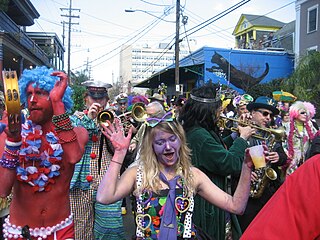
Mardi Gras is the final day of Carnival or Shrovetide before Ash Wednesday. Mardi Gras is French for "Fat Tuesday", reflecting the practice of the last night of consuming rich, fatty foods in preparation for the fasting season of Lent.

A krewe is a social organization that stages parades and/or balls for the Carnival season. The term is best known for its association with Mardi Gras celebrations in New Orleans, but is also used in other Carnival celebrations throughout Louisiana and along the Gulf of Mexico, such as the Gasparilla Pirate Festival in Tampa, Florida, Springtime Tallahassee, and Krewe of Amalee in DeLand, Florida with the Mardi Gras on Mainstreet Parade as well as in La Crosse, Wisconsin and at the Saint Paul Winter Carnival.

The Mistick Krewe of Comus (MKC), founded in 1856, is the oldest extant New Orleans, Louisiana Carnival Krewe, the longest to continually parade with few interruptions from 1856 to 1991, and continues to hold a tableau ball for its members and guests, to date. Initially its public facade was The Pickwick Club.

The holiday of Mardi Gras is celebrated in southern Louisiana, including the city of New Orleans. Celebrations are concentrated for about two weeks before and through Shrove Tuesday, the day before Ash Wednesday. Mardi Gras is French for Fat Tuesday, the season is known as Carnival and begins on 12th Night, January 6th, and extends until midnight before Ash Wednesday. Club, or Krewe, balls start soon after, though most are extremely private, with their Kings and Queens coming from wealthy old families and their courts consisting of the season's debutantes. Most of the high society Krewes do not stage parades. As Fat Tuesday gets nearer, the parades start in earnest. Usually there is one major parade each day ; many days have several large parades. The largest and most elaborate parades take place the last five days of the Mardi Gras season. In the final week, many events occur throughout New Orleans and surrounding communities, including parades and balls.

The Mardi Gras mystic society of Cain’s Merry Widows was founded in 1974 in Mobile, Alabama, home of the first Mardi Gras in America (1703). The organization celebrates 50 years in 2024. Each Mardi Gras, The ladies, known variously as "The Merry Widows of Joe Cain", "Joe Cain's Widows", or even just as "The Widows" gather on Joe Cain Day, clothed in black mourning clothes with veils, to lay a wreath at Cain’s burial site at Church Street Graveyard, wail over their "departed husband's" grave, then travel to Joe Cain’s former house on Augusta Street to offer a toast and eulogy to their "Beloved Joe".
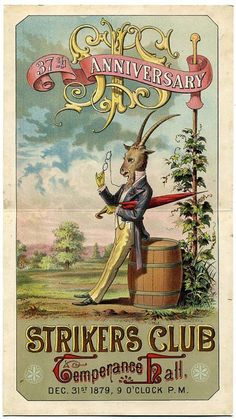
The Striker's Independent Society (SIS) is the oldest continuously active mystic society in Mobile, founded in 1843, Alabama. Mobile's Mardi Gras history spans over 300 years, as customs changed with the ruling nations: Mobile was the capital of French Louisiana in 1702, then British in 1763, then Spanish in 1780, entered the Republic of Alabama, was declared American in 1812, a U.S. state in 1819, then Confederate in 1860, then became American again in 1865 and participated in Carnival during New Year's Eve and New Year's Day celebrations. It is the oldest remaining mystic society in America but no longer hosts an annual parade.

Mardi Gras is the annual Carnival celebration in Mobile, Alabama. It is the oldest official Carnival celebration in the United States, started by Frenchman Nicholas Langlois in 1703 when Mobile was the capital of Louisiana. Although today New Orleans and South Louisiana celebrations are much more widely known for all the current traditions such as masked balls, parades, floats and throws were first created there. From Mobile being the first capital of French Louisiana (1702), the festival began as a French Catholic tradition. Mardi Gras has now evolved into a mainstream multi-week celebration across the spectrum of cultures, becoming school holidays for the final Monday and Tuesday, regardless of religious affiliation.
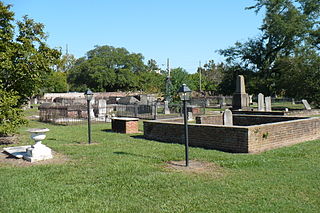
Church Street Graveyard is a historic city cemetery located in Mobile, Alabama. The cemetery is situated on 4 acres (1.6 ha) and is surrounded by a brick wall that dates to 1830. At the time that the cemetery was established it lay about a half mile away from most development, but it is now considered to be in downtown.

Mardi Gras throws are strings of beads, doubloons, cups, or other trinkets passed out or thrown from the floats for Mardi Gras celebrations, particularly in New Orleans, the Mobile, Alabama, and parades throughout the Gulf Coast of the United States, to spectators lining the streets. The "gaudy plastic jewelry, toys, and other mementos [are] tossed to the crowds from parading floats". The 'throws', consist of necklaces of plastic beads, coins called doubloons, which are stamped with krewes' logos, parade themes and the year, plus an array of plastic cups and toys such as Frisbees, figurines and LED trinkets. The plastic cups that are used as throws are sometimes referred to as New Orleans dinnerware.

A mystic society is a Mardi Gras social organization in Mobile, Alabama, that presents parades and/or balls for the enjoyment of its members, guests, and the public. The New Orleans Krewe is patterned after Mobile's Mystics. The societies have been based in class, economic and racial groups. Mobile's parading mystic societies build colorful Carnival floats and create costumes around each year's themes.
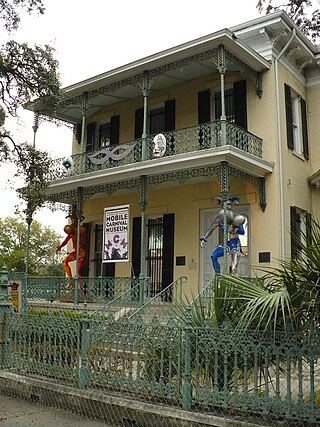
The Mobile Carnival Museum is a history museum that chronicles over 300 years of Carnival and Mardi Gras in Mobile, Alabama. The museum is housed in the historic Bernstein-Bush mansion on Government Street in downtown Mobile.
The Merry Widow is an operetta by Franz Lehár.

Mardi Gras in the United States is celebrated in a number of cities and regions in the country. Most of these places trace their Mardi Gras celebrations to French, Spanish, and other Catholic colonial influences on the settlements over their history.

The Paris Carnival is an annual festival held in Paris, France. The carnival occurs after the Feast of Fools and has been held since the 16th century or earlier, with a long 20th century interregnum.

The Order of Myths, (OOMs) founded in 1867, is the second oldest mystic society to celebrate Mardi Gras in Mobile, Alabama, after the Striker's Independent Society. It is the oldest continuously parading mystic society in Mobile. The Order of Myths chose, as its symbolic emblem, Folly chasing Death around a broken column of life. During parades, a person dressed in a jester's suit, as Folly, chases a person dressed in a skeleton suit as Death, around a Greek column on the emblem float. At the conclusion of the traditional OOM parade, Death is defeated, and Folly wins the day.

Mardi Gras Park is a municipal park in downtown Mobile, Alabama, US. The park is bounded by Government Street to the north, Royal Street to the east, Church Street to the south, and St. Emanuel Street to the west. The park opened in November 2016. It is located on the site of the old Mobile County Courthouse. The park features statues representing the Mardi Gras tradition of the City, including Mardi Gras royalty, jesters, and Joe Cain, who is largely credited with initiating the modern way of observing Mardi Gras and its celebrations in the city following the Civil War.
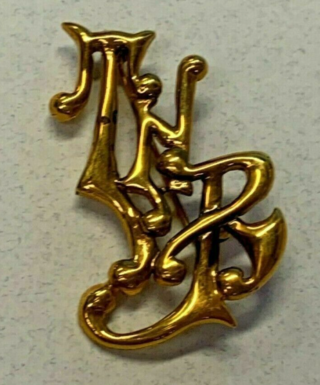
The Twelfth Night Revelers (TNR), founded in 1870, is a New Orleans, Louisiana, Carnival Krewe. It is the second oldest continuous organization of New Orleans Carnival festivities.
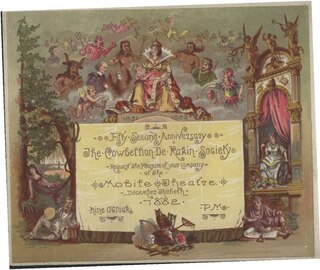
The Cowbellion de Rakin Society was the first formally organized and masked mystic society in the United States to celebrate with a pedestrian parade in 1830.




















